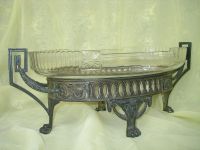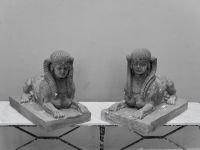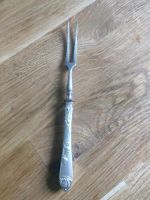











Krater Vasen Urne Bronze Klassizismus Sosibios Lampen Beisteller
1.357 € VB
Versand möglichBeschreibung
Paar Sosibios Krater Vasen Urne Bronze Klassizismus Lampen Beisteller Relief Römer
Prunkvolle Vasenpaar im Empirestil / Klassizismus
aus Bronze und Marmor,
Frankreich um 1860 - 1870
Topzustand in altersensprechendem Patina,
fein geformte florale und klassische Zierelemente
Relief : Etrusker / Griechen / Römer und Schlangen-, Entenhenkel
2 Krater Vasen - Urne Bronze Sehr seltene Form
Klassizismus Lampen Beisteller
"Bacchanalien"
Marmorsockel mit 2 Putten-Reliefs
sogenannte Sosibios Vase
H. ca. 36 cm, B. ca. 16 cm, T. ca. 10 cm
als Lampenhalter umgebaut (ohne Lampenschirm)
Prachtvolle dekorative Vasen mit Einsätzen und weit ausladenen Henkel
von höchster, schwerer Qualität, auf der Seite eines Sockels
ein kleine Fehlstelle im Marmor
Diese prachtvollen, dekorativen Vasen sind eine Zierde jeder Sammlung
Das Objekt befindet sich im benutzten Zustand mit altersentsprechenden Gebrauchspuren
Pare de Lampes en Bronze a Decor de Personnages antiques sur Socle en Marble
Dimensions : 36 cm de haut x 16 cm de larg x 10 cm de prof
Pair French Bronze Neo-Classical Urns with Black Marble Fluted Plinths
Mounted as lamps, the bronze urns are in the style of the "Sosibios Vase"
This vase, which once belonged to Louis XIV, testifies to the Roman taste
for sumptuous decorations for their villas and gardens.
The Athenian sculptor Sosibios, whose name is carved on the principal side,
was doubtless one of the Greeks active in Rome at the end of the Republic.
Working in the "Neo-Attic" style, he used the decorative repertoire of the Athenian workshops
and found inspiration in the ancient models.
Apollo, Artemis and Hermes,
here preside over a procession of Bacchic dancers.
Recent history of the work
Part of the royal collection of Louis XIV from 1692, the krater entered the Louvre in 1797 as confiscated property under the Revolution.
In the nineteenth century its fame of many reproductions, as for example in Sèvres biscuit ware in 1824.
John Keats (1795-1821) to write his Ode on a Grecian Urn.
This volute krater is the adaptation of a type of metal vessel known from the late fifth century, such as the Derveni Krater (Salonika Museum).
The ivy fronds decorating the neck and the gadroon motif on the lower part of the belly are also very close to Greek examples.
The handles terminate in swans'-necks at the lower attachments.On the belly, the relief decoration shows a Bacchic procession presided over Artemis and Hermes,who is standing by an altar with a burning brazier.
The goddess, with a quiver on her back, a bow in her left hand and holding a deer by the hoof, appears in her role as huntress.
Hermes is shown wearing the chlamys, the shortest traveler's cloak, and bearing the caduceus.
Maenads, female worshipers of Dionysus, dance to the sound of musical instruments and are accompanied by a dancing satyr,
an armed warrior and Apollo, who plays the cithara.
***************************************************
























